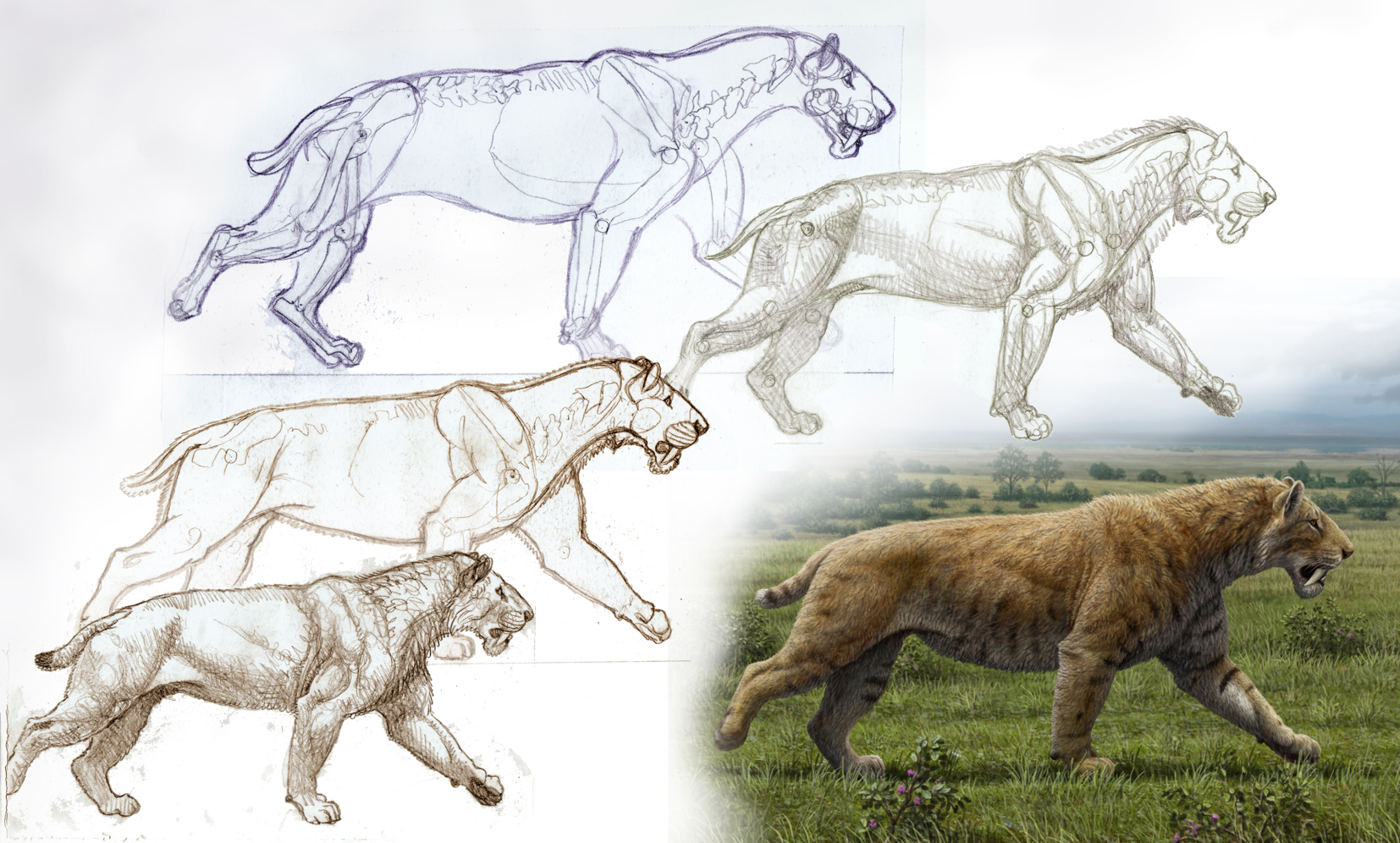
+- WildFact (https://wildfact.com/forum)
+-- Forum: Premier Section (https://wildfact.com/forum/forum-premier-section)
+--- Forum: Articles Archive (https://wildfact.com/forum/forum-articles-archive)
+--- Thread: Smilodon "bonaërensis" 46: The Forgotten Skeleton that Defined a Species (/topic-smilodon-bona%C3%ABrensis-46-the-forgotten-skeleton-that-defined-a-species)
Smilodon "bonaërensis" 46: The Forgotten Skeleton that Defined a Species - tigerluver - 06-22-2019
Smilodon "bonaërensis" - 46: The Forgotten Skeleton that Defined a Species
It is often touted that Smilodon populator had a unique body for a cat. Namely, with its relatively short hindlimbs and longer forelimbs, the knife-toothed beast's silhouette has long been described more like a hyena in proportion than a lion. One can see this image often in illustrations of the species, such as those by the legendary artist Mauricio Anton.

*This image is copyright of its original author
Reconstruction of Smilodon populator, from Mauricio Anton's Chasing Sabretooths.
Illustrations are plentiful, but an actual, official record a complete skeleton of Smilodon populator is difficult, if not nearly impossible, to find on the internet. A simple search with the appropriate keywords leads to many illustration and replicas of an ideal skeleton, but nothing of the real thing. In recent literature, only disarticulated bones have been described. Thus, where did the modern image of S. populator stem from? The answer lies in perhaps a long forgotten manuscript from 1933. In his doctoral thesis, El "Smilodón Bonaërensis", Muñiz : estudio osteológico y osteométrico del gran tigre fósil de la Pampa comparado con otros félidos actuales y fósiles, Rodolfo Mendez Alzola meticulously painted a near complete picture of one of the most iconic predators of the Pleistocene, Smilodon populator. His inspiration? The seemingly forgotten specimen known as Smilodon "bonaërensis" 46:

*This image is copyright of its original author
The only complete skeleton of Smilodon populator on record, originally logged as Smilodon "bonaërensis" 46 (Mendez Alzola 1933).
The skull of Smilodon "bonaërensis" 46 measures 345.7 mm in greatest length and 221.5 mm in width across the zygomatic arches. From the superior view, the skull is more rectangular like Machairodus rather than ovoid as in pantherines. Its iconic canines measure 242.5 mm in greatest length and 47 mm in greatest width. In comparison to Smilodon fatalis, the skull is a bit wider, with a zygomatic width to greatest length ratio of 0.64 (compared to average of 0.61 +/- 0.02 reported by Merriam and Stock (1932)). The mandible is relatively short and thin with a rather small and short masseteric fossa, a defining feature for Machairodontinae. Overall, the skull may have been more dependent on the canines than its musculature for its lethal function.

*This image is copyright of its original author
The skull of Smilodon "bonaërensis" 46 (Mendez Alzola 1933).
Smilodon "bonaërensis" 46 stood quite tall at the shoulder by modern standards. The combined length of the scapula, humerus, ulna, and third metacarpal is 125.67 cm. As in vivo these bones sit at an angle, the living shoulder height of the specimen was probably closer to 100 cm. The combined length of the pelvis, femur, tibia, and third metatarsal is 93.68 cm, thus in vivo the height at the hip would be about 80 cm. In terms of body frame, Smilodon "bonaërensis" 46 was one of the largest of its kind. Its long bones were greater in size than the largest S. populator mentioned by Christiansen and Harris (2005) which was estimated to weight 360 kg. In terms of robustness, the specimen represented the bear-like physique of its species. For instance, the most robust of today's big cats (i.e. the jaguar) have a humeral circumference to humeral length ratio of around 0.32. Smilodon "bonaërensis" 46 had a humeral circumference to humeral length ratio of 0.42, about one-third thicker than the stoutest of extant cats. The femur (femoral circumference to length ratio of 0.32) was also more robust than what is found in extant pantherines (femoral circumference to length ratio of 0.27), but not to the same degree as its humerus. The metapodials were also relatively short. All in all, the specimen was the first and perhaps only specimen to portray what the body of Smilodon looked like. Namely, a front heavy cat, with disproportionately thick and tall forelimbs and short hindlimbs that were meant for grappling over running.
Select measurements of Smilodon "bonaërensis" 46:

*This image is copyright of its original author
Original table of above image
| Dimension | Measurement (mm) |
|---|---|
| Skull length | 345.7 |
| Skull width(between zygomatic arches) | 221.5 |
| Superior canine length | 242.5 |
| Superior canine width | 47 |
| Scapula length | 396.5 |
| Humerus legth | 395 |
| Humerus least circumference | 164 |
| Ulna length | 367.6 |
| Metacarpal III | 97.6 |
| Pelvis dorsa-ventral diameter | 136.2 |
| Femur length | 408 |
| Femur least circumference | 131 |
| Tibia length | 294.2 |
| Metatarsal III | 98.4 |
Today, Smilodon "bonaërensis" 46 resides in the Museo Argentino de Ciencias Naturales. The type specimen for the species Smilodon populator, it remains one of the most invaluable finds in Pleistocene paleontology. The text inspiring this article can be found in link in the references below.
References:
Méndez Alzola, Rodolfo. (1933). El Smilodón Bonaërensis, Muñiz : estudio osteológico y osteométrico del gran tigre fósil de la Pampa comparado con otros félidos actuales y fósiles. Facultad de Ciencias Exactas y Naturales. Universidad de Buenos Aires.
Merriam, John Campbell, and Chester Stock. The Felidae of Rancho La Brea. No. 422. Carnegie institution of Washington, 1932.
Christiansen, P., & Harris, J. M. (2005). Body size of Smilodon (Mammalia: Felidae). Journal of Morphology, 266(3), 369-384.
This article is part of a new series published at WildFact. Comments, questions, and the like regarding this article can be posted here.